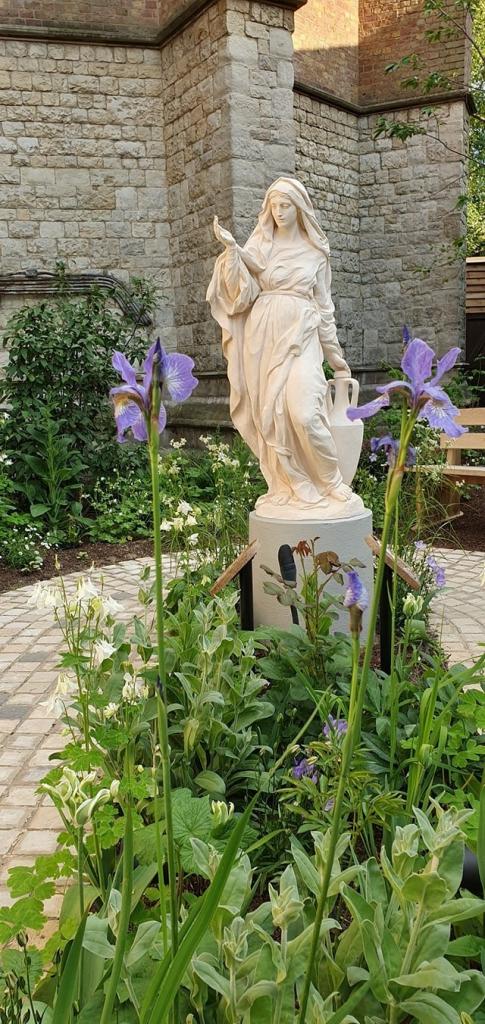by Fr Lawrence Lew OP
The Dominican friars have been propagators of the devotion of the Holy Rosary for centuries. Indeed tradition holds that Our Lady gave the Rosary to St Dominic, and, for almost 800 years, the Dominicans have been preaching and teaching the Rosary as a prayerful meditation on the saving mysteries of Christ. The Dominican custom was to group these mysteries into sets called the Joyful, Sorrowful, and Glorious Mysteries, and this arrangement is seen in the architecture of the Dominican church in Haverstock Hill, which has chapels and stone-carved altars dedicated to each of the traditional fifteen mysteries of the Rosary. In 2016, Cardinal Vincent thus declared this unique Church of Our Lady of the Rosary and St Dominic to be a Rosary Shrine for the whole diocese. At that time, he also called on the Dominican friars to continue their mission of preaching the Rosary.
It wasn’t until 2002 that Pope St John Paul II introduced a new set of mysteries to the traditional Rosary, and he did this in order to renew this ancient devotion, and to extend its Christological focus so as to include the ministry of Christ and the sacramental order that he established. These five new mysteries were probably inspired by a set preached by the Maltese saint, George Preca, in 1957; Pope John Paul II had only just canonised him in 2001. They both referred to these new mysteries of the Rosary as the Mysteries of Light, or the Luminous Mysteries.
Pilgrims to the Rosary Shrine in London, perhaps unaware of the relative novelty of the Luminous Mysteries, sometimes wondered why these mysteries were not represented in the Rosary Shrine, a church that was completed in 1883. The Dominican friars were conscious of this pastoral need, and they also reflected on the Cardinal’s invitation to them to reinvigorate the preaching and praying of the Rosary at the Shrine. Hence, a decision was made in 2017 to turn the disused land behind the Lady Chapel into a Rosary Garden commemorating the Luminous Mysteries, and a fundraising campaign was launched.
Thanks to the generosity of parishioners and benefactors, what was once a dark and barren wasteland, unused for decades behind the church, has now been transformed into a Marian sanctuary of beauty, colour, and light. A wheelchair-accessible oval sandstone path, with black granite beads marking out a Rosary on the path, has been marked out in the centre of the garden. Around this are five comfortable memorial benches, nestled between rose bushes and swaying foxgloves, where one can sit and contemplate and pray. In the heart of the garden, ringed by this path, is a bed of beautiful Marian flowers which surround five plaques illustrating the five Mysteries of Light: the Baptism of the Lord, the wedding at Cana, the preaching of the Kingdom and call to conversion, the Transfiguration, and the Institution of the Holy Eucharist. These plaques were made by the nuns of the Monastic Family of Bethlehem. The centrepiece of the garden, however, is a specially-commissioned statue of Our Lady of Cana, whose lips are open to say: ‘Do whatever he tells you.’ (John 2:5) This elegant and serene statue was designed and sculpted by the internationally-renowned Catholic sculptor Cody Swanson, who is based in Florence. The statue, made from a special sculpting clay, was created in Florence, and then shipped to London and personally installed by the artist just days before the garden opened.
The Luminous Mysteries Rosary Garden was opened and blessed on 24th May 2019. The Dominicans observe the feast of the Translation of the Relics of St Dominic on this day (see opposite page), but it is also, fittingly, the feast of Our Lady Help of Christians, an invocation that is linked to Pope St Pius V who prayed the Rosary and implored her help during the battle of Lepanto in 1571.
At the Garden Inauguration Mass, the Rosary School choir sang motets in praise of Our Lady, and afterwards, the children handed out prayer cards of each of the Luminous Mysteries which they had made. Present at that Mass was the acclaimed Catholic composer Sir James MacMillan CBE, who enthused over the splendid sung liturgy of the Rosary Shrine; and he especially praised the children for their sweet singing of the Gregorian chant Ordinary of the Mass. After the Mass, the friars and congregation processed to the Rosary Garden, singing the Dominican Litany of Our Lady. The Garden and Marian statue were blessed by Abbot David Charlesworth OSB, from Buckfast Abbey which has just celebrated its millennial year, and then Fr Thomas Skeats OP, Parish Priest, crowned the statue of Our Lady of Cana. At this point, the Rosary Shrine choir broke out into a madrigal-like composition by Martin Stacey, Director of Music at St Dominic’s.
A public path runs directly past the new Rosary Garden, so it has gained much attention from passers-by as it was being put together. Now that it is opened, the friars and parishioners have found that the garden is a wonderful bridge for conversations and dialogue with local people, and many who would not enter a church happily come into the garden and talk to the priests and laity. Children especially love the garden, and they have even played with the Priory cat when he’s in there too; the garden has become a tool for pre-evangelisation. The Westminster Curia of the Legion of Mary became the first group to pray the Luminous Mysteries in the garden, and other pilgrims and visitors have come to pray, sit, and reflect in the company of Our Lady of Cana.
The Rosary Garden is currently opened only when there are volunteers to supervise, and the weekly opening times are online at http://rosaryshrine.co.uk and https://www.facebook.com/RosaryShrineUK/




